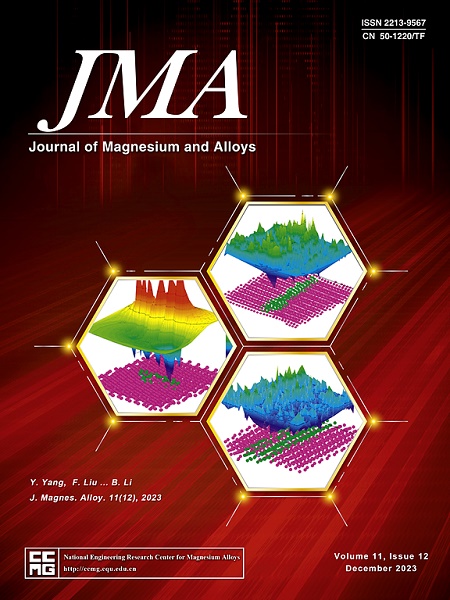离子识别可以实现快速的Mg - cl键解离动力学和更好的Mg电镀/剥离可逆性
IF 15.8
1区 材料科学
Q1 METALLURGY & METALLURGICAL ENGINEERING
引用次数: 0
摘要
可充电的镁金属电池在可再生能源的储存和利用方面具有相当大的前景。然而,Mg剥离/镀过程中离子对离解动力学缓慢,导致速率和循环性能较差。在这项工作中,一个有效的骨架宿主含有不同电负性的不同偶联元素,通过加速Mg-Cl键解离过程来促进界面反应动力学。作为概念验证原型,通过沸石咪唑酸框架-67 (ZIF-67)的高温退火,合成了嵌入碳质多面体的N/ o掺杂钴纳米颗粒。暴露的富电子N/O位和缺电子Co位分别通过化学配位键与Mg2+和Cl -选择性结合,调节[Mg-Cl]+络合离子的吸附结构构型。键长从2.596 Å延长至2.679 Å,键强度减弱,有利于络合离子的解离,从而获得更好的电荷转移动力学。此外,良好的亲镁性和导电多孔渗透的三维结构实现了镁的均匀电沉积和电极动力学的改善。在有机卤化铝酸镁电解质(从290 mV到189 mV)和传统的Mg(TFSI)2基电解质(从600 mV到200 mV)中都证实了过电位的降低。所设计的骨架主机还具有2300 h以上的超长循环寿命和700次循环内99.65%的超高平均库仑效率。加速键分裂策略可以提高金属阳极的可逆性,这对高浓度或其他含有大量离子对或聚集体的电解质系统也很有帮助。本文章由计算机程序翻译,如有差异,请以英文原文为准。
Ion recognition enables fast Mg–Cl bond dissociation kinetics and better Mg plating/stripping reversibility
Rechargeable Mg-metal batteries hold considerable promise for renewable energy storage and utilization. However, the Mg stripping/plating processes suffer from sluggish ion pairs dissociation kinetics, resulting in poor rate and cycle properties. In this work, an efficient skeleton host containing dissimilar coupling elements with varied electronegativity has been designed to promote interfacial reaction kinetics by accelerating the Mg–Cl bond dissociation process. As a proof-of-concept prototype, the N/O-doped cobalt nanoparticles embedded in carbonaceous polyhedrons has been synthesized via facile high temperature annealing of zeolitic imidazolate framework-67 (ZIF-67). The exposed electron-rich N/O sites and electron-deficient Co sites can regulate the adsorbing structure configuration of [Mg-Cl]+ complex ions by selectively bonding with the Mg2+ and Cl– through chemical coordination linkage, respectively. The elongated bond length from 2.596 Å to 2.679 Å and the weakened bond strength are beneficial for the complex ions dissociation, leading to better charge transfer kinetics. In addition, the better magnesiophilic property accompanied by the conductive and porous permeable three-dimensional architecture realizes the homogeneous electrodeposition of Mg and improved electrode kinetics. The decreased overpotential has been verified in both magnesium organohaloaluminates electrolyte (from 290 mV to 189 mV) and conventional Mg(TFSI)2-based electrolyte (from 600 mV to 200 mV). The designed skeleton host also exhibits excellent long cycle lifespan above 2300 h and extra-high average Coulombic efficiency of 99.65 % within 700 cycles. The accelerated bond splitting strategy enables improved metal-anode reversibility, which is also insightful to high concentrated or other electrolyte systems that contain abundant ion pairs or aggregates.
求助全文
通过发布文献求助,成功后即可免费获取论文全文。
去求助
来源期刊

Journal of Magnesium and Alloys
Engineering-Mechanics of Materials
CiteScore
20.20
自引率
14.80%
发文量
52
审稿时长
59 days
期刊介绍:
The Journal of Magnesium and Alloys serves as a global platform for both theoretical and experimental studies in magnesium science and engineering. It welcomes submissions investigating various scientific and engineering factors impacting the metallurgy, processing, microstructure, properties, and applications of magnesium and alloys. The journal covers all aspects of magnesium and alloy research, including raw materials, alloy casting, extrusion and deformation, corrosion and surface treatment, joining and machining, simulation and modeling, microstructure evolution and mechanical properties, new alloy development, magnesium-based composites, bio-materials and energy materials, applications, and recycling.
 求助内容:
求助内容: 应助结果提醒方式:
应助结果提醒方式:


